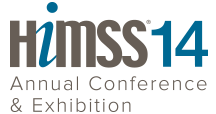Highlights from HIMSS 2014
March 4, 2014
Categories: Thought Leadership
 In the last week of February, more than 37,000 health IT professionals, clinicians, health care industry executives and even former Secretary of State Hillary Clinton, all gathered in Orlando for the annual Healthcare Information and Management Systems Society (HIMSS) Conferen
In the last week of February, more than 37,000 health IT professionals, clinicians, health care industry executives and even former Secretary of State Hillary Clinton, all gathered in Orlando for the annual Healthcare Information and Management Systems Society (HIMSS) Conferen In the last week of February, more than 37,000 health IT professionals, clinicians, health care industry executives and even former Secretary of State Hillary Clinton, all gathered in Orlando for the annual Healthcare Information and Management Systems Society (HIMSS) Conference and Exhibition.
In the last week of February, more than 37,000 health IT professionals, clinicians, health care industry executives and even former Secretary of State Hillary Clinton, all gathered in Orlando for the annual Healthcare Information and Management Systems Society (HIMSS) Conference and Exhibition.CNSI was on hand among 1,200 other leading technology providers to explore the latest developments and industry insights that are showcased on the exhibit floor.
To kick off the event, Aetna CEO Mark T. Bertolini emphasized the need for reform in payment models and in investing in wellness for the chronically ill. However, it was Hillary Clinton who drew the largest crowds for her discussion on the importance of electronic health records and IT infrastructure. Clinton praised HIMSS attendees for being part of the solution in transforming health IT practices and emphasized ways that technology enables better care. She focused on the need for utilizing “good data” in order to make informed decisions, stating, “It’s important to be guided by evidence about what works and what doesn’t, not ideology or past practices, or personally held beliefs.”
Conference attendees also learned about the findings of the 25th annual HIMSS Leadership Survey, which evaluated data from 650 different hospitals across the nation and found that sustaining financial viability remains top of mind for the industry.
According to a news release discussing the survey, one of the most notable findings concerns “the perceived impact financial resources are having on IT implementations. While a majority of the survey participants (65 percent) reported IT budget increases – which is likely a contributing factor to the transition to a paperless environment—a lack of adequate financial resources now tops the list of barriers to successful IT implementation.”
Although, if transitioning to a paperless environment is any sign of progress, then we’ve made great strides in the past few years. Overall, the survey showed that efforts by the federal government to encourage IT adoption are working. As outlined in an infographic that accompanied the survey, since June of 2011 the number of hospitals that have achieved the highest level of progress towards a paperless environment has increased by 164 percent.
What do you think made the biggest splash at HIMSS14? Tweet @CNSICorp to let us know!
Follow CNSI on Twitter.

Thought Leadership
March 16, 2022CNSI Solution Delivers Stand-Out Performance at Payer-to-Payer Connectathon

Thought Leadership
February 11, 2022Taking Technology Personally: CNSI Managing Director Gaurav Maini profiled in Forbes India

Thought Leadership
September 29, 2021CNSI’s Follow-the-Sun Development Model Supports Ongoing MMIS Modernization: IEEE Software September/October 2021




